Gustav and the Louisana Offshore Oil Port -- What do we need to know?
Posted by JoulesBurn on September 2, 2008 - 10:12am
Hurricane Gustav has brushed by the Louisiana Offshore Oil Port (LOOP), where 1.2 million barrels of oil per day is offloaded from supertankers. Here is the recent trajectory of Gustav superimposed on a map of the LOOP area, including Port Fourchon, also of critical importance to the production of oil from the Gulf of Mexico.
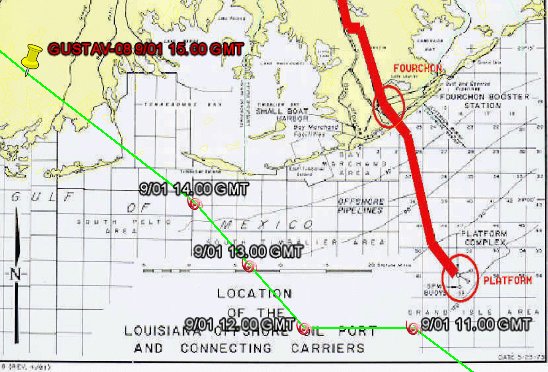
The LOOP is an offshore crude oil offloading facility consisting of a central Marine Terminal Platform surrounded by several Single Point Moorings (SPMs) which are tethered to the ocean floor. The platform and moorings are located in the circled region in the lower right corner in the above image. The eye of Gustav passed just over seven miles to the southwest of this area. The MSNBC Hurricane Tracker site has that Gustav was just between category 3 and category 2 status (110-115 mph) as it made the slight jog to the west.
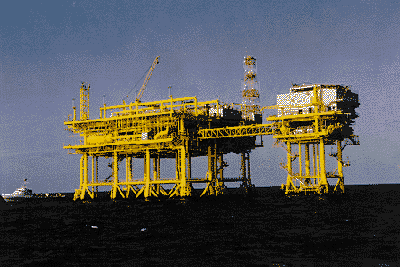 |
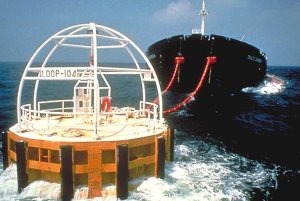 |
The Marine Terminal (yellow structure in the above image) coordinates vessel traffic in the vicinity of the LOOP, maintaining safe distances between tankers. For oil offloading, tankers are tethered to one of the moorings and flexible hoses bring oil from the tankers and pass it into one of several sea-floor pipelines spanning the 20 mile distance to the Fourchon Booster Station located onshore.
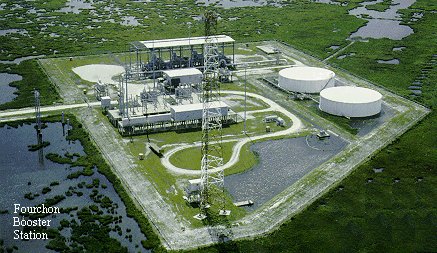
From there, it is piped north to the Clovelly Dome Storage Terminal (45 million barrel capacity) from where it is dispersed to refineries.
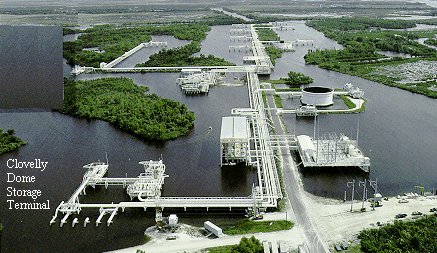
The LOOP was not severely damaged by Hurricane Katrina three years ago:
LOOP sustained "no apparent catastrophic damage" and should be able to quickly resume offloading tankers once power is restored to its onshore pipeline systems, a spokesman says.
He tells Platts that utility Entergy (ETR) was working to restore power to the onshore systems, which must be in operation before the offshore terminal can begin unloading crude from tankers. The offshore terminal, 20 miles south of the Louisiana coast, has its own power source.
"Power is our biggest need... It shouldn't take us terribly long to get back once we get power," he says. LOOP could resume offloading vessels once power is restored "probably within a matter of hours."
As for the damage to the LOOP from Gus, we will have to wait and see. Operations were shut down as of the morning of Aug. 31. For the longer term, there are plans to complement the LOOP with a 1.8 million BPD terminal located 36 miles offshore from Freeport, TX:
http://cbs11tv.com/business/texas.offshore.terminal.2.797981.html




Thanks! Looks like an interesting place.
You say that LOOP has its own power source. What is that? I know that platforms run on electricity generated by the natural gas they pump. Are there nearby pipelines that LOOP gets its natural gas from, or does it burn diesel? Natural gas is usually a whole lot less expensive, if it is available.
Thanks.
It's great to see it and get some real perspective on what we are talking about.
That tidbit came from the BW article. I cannot determine if it normally runs on its own power source or if it just has backup generators. Some reports indicate that, after Katrina, the LOOP ran at reduced capacity for a few days due to less electricity available at the Booster Station.
Here is a listing of the current infrastructure outage due to Gustav, from Reuters:
Nice piece! Here's a Joules-esque piece I found on the SPR: Eyeballing the Strategic Petroleum Reserve. DOE has drawn the shades on details on it.
I've heard local news reports of ca. 750k customers without power.
Assume the refineries may not have power either. Entergy stated this was the worse blackout in its 95 year history:
http://www.bloomberg.com/apps/news?pid=20601103&sid=ahy3tk8DSse8&refer=us
Estimates of 500,000 - 900,000 homes without power so far.
There was a news report that some of the power stations themselves may have suffered damage, but no further details.
The SPR piece is interesting. It shows maps and Google Earth images of the Strategic Petroleum Reserve. The same link also has a write-up about it.
Speaking of the SPR: O&G Journal: Gustav idles 12% of US refining capacity
Never having seen the SRP, I went looking and found pictures of it on Google and here, I believe is its location.
Article w/picture
http://www.salem-news.com/articles/october182007/petro_reserves_101807.php
Lat/Lon 28.917518,-95.381284
http://maps.google.com/maps?f=q&hl=en&geocode=&q=28.917518,-95.381284&ie...
SMH
I find it difficult to believe that there is only one storage location. It would not be very strategic to put all the eggs on one basket, would it?
Check out the hurricane thread yesterday, which links to a site where the SPR locations are listed and have pictures - I believe there are 4 of them.
A fifth SPR (smaller than the others) is under construction in Mississippi.
In addition, there is a 2 million barrel heating oil reserve in the Northeast (2 or 3 locations).
Alan
Why have they put all 4/5 in the south east near the hurricane zone? Surely it would make sense to have something on the west coast? (but not in an earthquake zone:-)
The entire West Coast is an earthquake zone.
Well, if you could find a salt dome on the West Coast, the DOE might be interested.
http://www.forbes.com/reuters/feeds/reuters/2008/09/02/2008-09-02T220626...
Citgo asks for oil from emergency US oil reserve
09.02.08, 6:06 PM ET
Requiring oil to distributed 97% of food is not very strategic either. Even if the SPR was spread across 100 sites.
Forbes:
No major visible damage to Port Fourchon (LOOP):
http://www.forbes.com/home/2008/09/02/gustav-highways-energy-biz-cx-wp_0...
Actually....
Louisiana Port May Resume Some Oil Deliveries Within a Week
By Christopher Martin
Sept. 2 (Bloomberg) -- Louisiana's Port Fourchon, partially flooded and cut off from roads by Hurricane Gustav, may be ready to service up to half of U.S. offshore rigs and platforms in the Gulf of Mexico within a week.
``We had some considerable damage from the hurricane,'' Ted Falgout, director of Port Fourchon, said today in an interview. ``We've now got crews on the ground and should be able to help service rigs within a week.''
More than 60 companies that use the port were sending teams in today to assess damage to their own equipment, Falgout said. He estimates that the port, using backup generators until utility power is restored, should be able to handle as much as 50 percent of normal traffic in a week